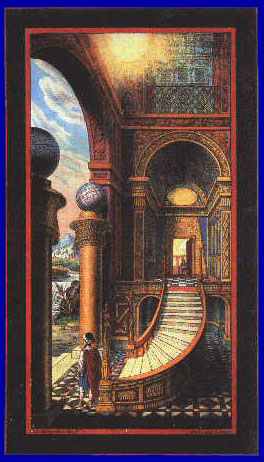The Pillars of Jachin and Boaz
By H.L. Haywood
THE AGE in which we now live began at the foot of the
Caucasus Mountains some 7,500 years ago, and had its first
origin in a community near a region from which there were
passes and routes in all directions to regions round about,
and for that reason was called Nineveh, or "the Nine Ways."
From there the schools of architecture, medicine, and
language were gradually extended eastward across the vast
and (then) fertile region that is now called Iran, Arabia, Iraq.
Known history goes no farther back, though archeologists
can make some reasonable guesses toward regions of the
antique peoples that stood here and there among the
Caucasus. The founders of the new age along the foot of the
Range called themselves Aryans, and used a language
called Sanskrit, from which our later languages derived
through Greek and Latin.
After a number of nomad peoples had overflowed from the
north southwards into the vast plains which lay eastward,
they flourished for a thousand years or so among their tents,
surrounded by their numerous flocks and herds of sheep and
goats; they then began to move westward, while the Aryans,
with their cattle, gradually moved southwards and
westwards; and though at first the nomads, or Semites as
they called themselves, moved in peace they came at last to
resort to war, often of a frightfulness beyond belief.
Ultimately they crowded out most of the Aryans from the
Fertile Crescent of the Tigris and Euphrates Rivers, and
there built a vast city of their own called Babylon. In and
around it they perfected a wonderful language, since called
Babylonian. This was the parent Semite language, just as
the Sanskrit before it had been the parent Aryan language.
From the Babylonian came after a while a number of
languages such as Syriac and Hebrew. The words jachin
and boaz occur in nine of those languages.
The Semitic towns and cities were walled. Through each
principal gate passed a straight road into regions across the
city's own immediate territory. At the point where a road
crossed the line of that city-state two columns were erected,
both hollow, in which were placed tablets of clay or paper on
which were inscribed in brief form the laws and rules to be
observed inside the city. The one in which were placed all
such laws and regulations as we should call political
because they had to do with courts, police, crimes, penalties,
etc. was called a jachin. In the other were placed such laws
and rules as were to govern deportment, behavior, etiquette,
rites, ceremonies; it was called a boaz.
It is evident that since the two columns in front of Solomon's
Temple were given those names it was because they were
for the old and familiar (among Semites) purposes. If so,
they were hollow, and in the pachira were placed the written
laws and rules for the government of the building and its
precinct, and in the boaz were placed the laws and rules for
the regulations of conduct, rites and ceremonies.
![]()

